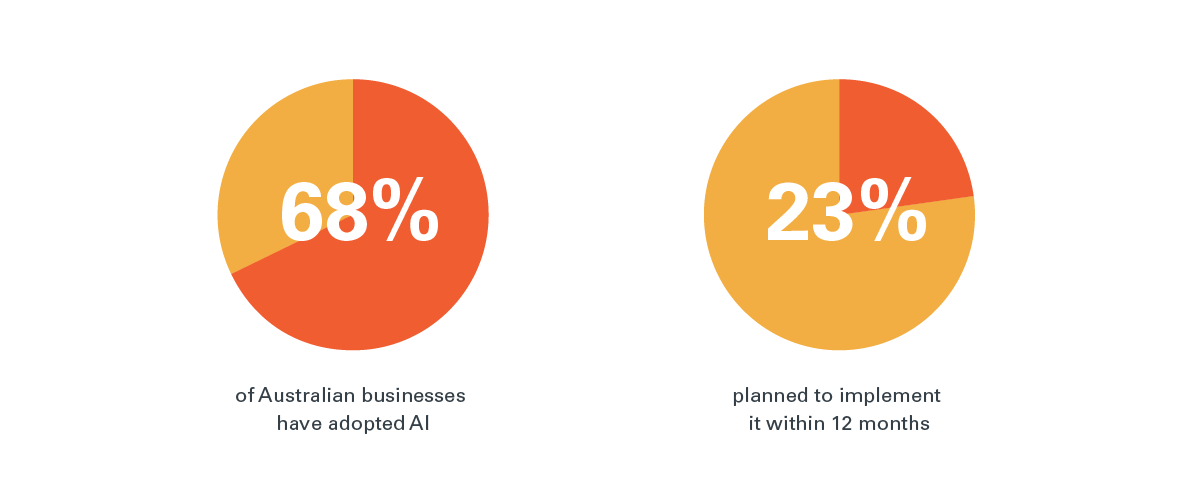As of March 2023, the CSIRO found that 68% of Australian businesses had adopted AI and 23% planned to implement it within 12 months. In December last year, the Australian Government announced a $17 million initiative to help SMEs adopt artificial intelligence (AI). The initiative aims to kickstart Australian SMEs towards leveraging AI's benefits and competitive advantages.
However, adopting AI requires more than just financial backing. The Government's initiative acknowledges this by emphasising that it will support SMEs in adopting AI responsibly and efficiently.
Before 'switching on' AI in your business, you need a clear AI business strategy that aligns adoption with the business goals. Critical to this strategy is a strong focus on data integration. Why? Because AI needs comprehensive and reliable information for it to produce reliable results. (Remember the old saying, ‘Garbage in, garbage out’). The best way to ensure that is to automate data flow between systems and into the AI service. Effectively using AI depends on access to well-organised, clean business information to produce reliable insights. Without consistent data sources, your organisation will struggle to get the results you were hoping for in your AI experimentation.
AI adoption in Australia, March 2023

Source: CSIRO.
Business applications of AI
Leveraging predictive analytics: Predictive analytics enable teams at all levels of the business to understand potential trends and challenges. It uses historical data to understand behaviour patterns, trends, and outcomes and predict future scenarios. Predictive analytics supports decision-making and sharpens a company's competitive edge by identifying opportunities and risks ahead of time.
Advanced pattern recognition: AI can identify complex patterns and trends that might elude human analysts. Using machine learning algorithms, AI analyses complex datasets to uncover insights.
Converting data into business insights: AI facilitates fast, data-driven decision-making for various industries. For many businesses, the challenge lies in converting 'dirty' data into actionable insights. AI addresses this challenge by processing large datasets, identifying relevant patterns, and extracting valuable insights without the bottlenecks of manual work. By eliminating the time-consuming processes associated with manual analysis, AI enables leaders and teams to respond quickly to business and market changes.
Empowering non-technical employees: In the past, only technically-minded people worked with data. Today, AI brings data-driven insights to people at all levels of the business to support decision-making.

Challenges to address before adopting AI
If your organisation adopts AI tools without preparing the information that you need to supply those tools, you will likely experience the following complications:
Data silos
Data silos prevent AI systems from providing a holistic analysis that accounts for every data point. When data remains isolated, it obstructs AI's access to a comprehensive dataset and limits the effectiveness of insights generated. This isolation can stifle decision-making processes, as AI tools cannot provide leadership teams with the full scope of available information.
Data quality and bias
Inconsistencies, errors, and disparities in data – often resulting from inadequate integration/automation – can skew AI outputs, leading to biased decisions and poor outcomes. On the flip side, high-quality data influences the reliability and fairness of AI-driven insights.
Inefficiency and delays
AI business solutions need complete, consistent, and up-to-date data to provide up-to-date insights. The absence of automated data flows forces businesses to rely on manual efforts to get that data to the AI service. Without integration, the organisation will experience inefficiencies, prolonging the time to derive actionable insights from AI analyses. Such delays can be detrimental in fast-paced market environments where organisations rely on timely decision-making.
Limited AI adoption and innovation
Without a solid data foundation, your company will struggle to leverage AI successfully. Disconnected data sources can impede the training and refinement of AI models. Organisational challenges, including alignment between departments and securing the necessary talent, become more pronounced, affecting the overall success and progression of AI initiatives.

A data integration strategy unlocks AI's potential
Okay, this may sound tedious but stick with me for a moment, and you’ll see it isn’t that complex. Data integration bridges the gaps between siloed systems to ensure that AI models can access a consistent and consolidated data flow. For instance, real-time analytics are impossible without data integration.
An integration strategy can be reasonably simple if done correctly. The purpose of it is to have a central point of reference (both information and staff members) so that as ideas come up for automating the movement of data around the business, a common practice is developed, and skills are reused and refined.
You could also incorporate a data governance framework. This framework can be used as a guide for following data management practices, ensuring data quality, and maintaining consistency across different systems. It lays down the policies and standards for data usage, ensuring that AI models use reliable and relevant data.
Your integration strategy (and/or the framework) can start simply while you are testing the water and growing as your needs mature. You don’t have to solve everything. A simple strategy, with incremental improvements over time, will lead to a much better flow of business information than waiting for the day when you have the resources to do everything. (trust me, that day never comes).
Data preprocessing and labelling also support data quality. Preprocessing cleans and transforms data into a format suitable for analysis, enhancing the data quality even before AI systems use it. Data labelling, on the other hand, is the process of identifying raw data and tagging it with informative labels, making it easier for AI models to understand and learn from the data.
By embedding these practices into your data integration strategy, your organisation can ensure that AI systems have access to high-quality, consistent, and comprehensive data sources. This, in turn, significantly enhances the reliability and effectiveness of AI-driven analyses.

Conclusion
Using artificial intelligence for business creates numerous opportunities to make the most of your data with predictive analytics, pattern recognition, and automated insight generation, reshaping traditional approaches to data analysis. However, before your organisation can see success with AI, you must be certain of the information you’re passing through to it. Without data integration, AI's effectiveness becomes very limited.
Addressing challenges like data silos, inaccuracies, privacy concerns, inefficiencies, and barriers to adoption is essential for leveraging AI fully. Data integration offers solutions to these obstacles. As businesses tackle data management complexities and AI integration, focusing on comprehensive and accessible data will unlock AI's potential. This approach ensures enterprises stay ahead in a data-centric landscape, fully leveraging AI's transformative power for competitive advantage and innovation.
Creative Folks can guide your data integration strategy
Before starting your AI journey, you need a data strategy and a partner who can guide you in the right direction. Our team excels in aligning data integration strategies with your business goals, laying the foundation for successful AI adoption. By understanding your unique ecosystem, we identify and implement bespoke integration solutions that pave the way for AI to drive your business forward. Visit our Systems Integration page for more information and to start your journey.
Related blogs
Solving modern business challenges with Data Integration
What data integration challenges occur during an M&A?
Transform data into action with real-time dashboards



 Previous
Previous



